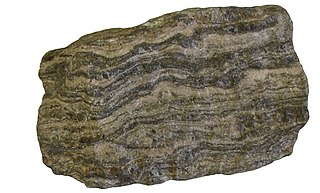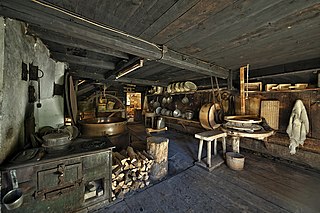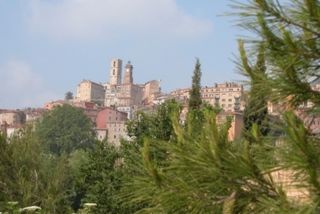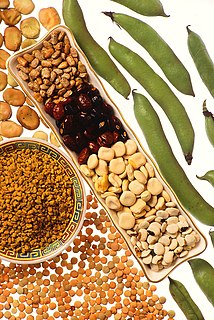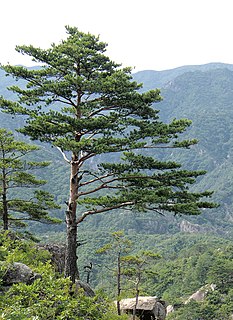
Prairies are ecosystems considered part of the temperate grasslands, savannas, and shrublands biome by ecologists, based on similar temperate climates, moderate rainfall, and a composition of grasses, herbs, and shrubs, rather than trees, as the dominant vegetation type. Temperate grassland regions include the Pampas of Argentina, Brazil and Uruguay, and the steppe of Ukraine, Russia and Kazakhstan. Lands typically referred to as "prairie" tend to be in North America. The term encompasses the area referred to as the Interior Lowlands of Canada, the United States, and Mexico, which includes all of the Great Plains as well as the wetter, hillier land to the east.

In soil science, Podzols are the typical soils of coniferous or boreal forests. They are also the typical soils of eucalypt forests and heathlands in southern Australia. In Western Europe, Podzols develop on heathland, which is often a construct of human interference through grazing and burning. In some British moorlands with Podzolic soils, Cambisols are preserved under Bronze Age barrows.

Quadra Island is an island off the eastern coast of Vancouver Island, British Columbia, Canada, part of the Discovery Islands located within the Strathcona Regional District. Quadra Island is about 35 kilometres from its northernmost point to its southernmost point. The island at its narrowest point, on its southern peninsula, is less than 2 km (1.24 mi) wide, and at its widest point, about 15 km (9 mi) wide. Quadra island is about 310 square kilometres in area. The population of island and surrounding mainland inlets, as of the 2006 federal census, was 2,472, down from the 2001 federal census count of 2,548. In 1903 it was named after the Spanish navigator Juan Francisco de la Bodega y Quadra, who explored and settled the Vancouver Island area in the late 18th century. It is separated from Vancouver Island by Discovery Passage, and from Cortes Island, and is linked to that island by a ferry from Heriot Bay on its eastern shore. The island has many beaches, trails, lakes, and parks. Main Lake Provincial Park is located on the northern part of the island, and Rebecca Spit Marine Provincial Park is on the eastern shore, near Heriot Bay.
Parent material is the underlying geological material in which soil horizons form. Soils typically inherit a great deal of structure and minerals from their parent material, and, as such, are often classified based upon their contents of consolidated or unconsolidated mineral material that has undergone some degree of physical or chemical weathering and the mode by which the materials were most recently transported.
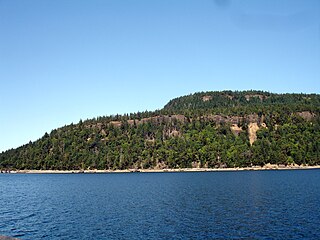
Hornby Island of British Columbia, Canada, is a Salish Sea island located near Vancouver Island's Comox Valley.

Hubbard Brook Experimental Forest is an area of land in the towns of Woodstock and Thornton in the White Mountains of New Hampshire that functions as an outdoor laboratory for ecological studies. It was initially established in 1955 by the United States Forest Service for the study of the relationship between forest cover and water quality and supply.

The Town of Brome Lake is a town in southern Quebec, Canada. It is located in the Brome-Missisquoi Regional County Municipality of the Montérégie administrative region. The population as of the Canada 2011 Census was 5,609.

Originally mapped in Cecil County, Maryland in 1899, more than 10 million acres (40,000 km²) of the Cecil soil series are now mapped in the Piedmont region of the southeastern United States. It extends from Virginia through North Carolina, South Carolina, Georgia and Alabama, with the typic Cecil pedon actually located in Franklin County, NC. A map showing the actual extent of the Cecil series is available at the Center for Environmental Informatics
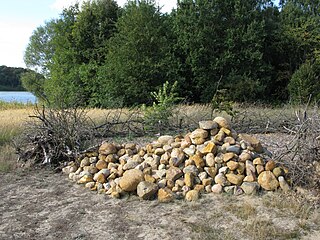
Fieldstone is a naturally occurring type of stone, which lies at or near the surface of the Earth. Fieldstone is a nuisance for farmers seeking to expand their land under cultivation, but at some point it began to be used as a construction material. Strictly speaking, it is stone collected from the surface of fields where it occurs naturally. Collections of fieldstones which have been removed from arable land or pasture to allow for more effective agriculture are called clearance cairns.

Eagle Heights is an elevated area located south of Koksilah Ridge on Vancouver Island, British Columbia, Canada. It is centered at 48°40′N, 123°46′W. Its summit lies about 836 meters above sea level. Populated areas where it is visible include North Saanich, Sidney, and Shawnigan Lake.
The Canadian System of Soil Classification is more closely related to the American system than any other, but they differ in several ways. The Canadian system is designed to cover only Canadian soils. The Canadian system dispenses with the sub-order hierarchical level. Solonetzic and Gleysolic soils are differentiated at the order level.
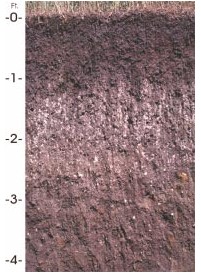
Houdek is a type of soil composed of glacial till and decomposed organic matter. It is found only in the U.S. state of South Dakota where it is the state soil. The soil series was established in 1955 in Spink County, South Dakota. It is unique to the United States, but in particular to South Dakota where it is the state soil.
Charlottetown soil series is the name given to a deep fine sandy loam soil which has developed under forest vegetation on glacial till. This series occurs only on Prince Edward Island, where it is widespread and so important for agriculture that it has been designated as the Provincial Soil.
Blandford soil series is the name given to a loam or sandy loam soil which has developed on glacial till in parts of southern Quebec and northern New England. It belongs to the brown podzolic soil group and occurs in hilly areas of the Green Mountains in Vermont plus the adjoining Sutton Mountains in Quebec. In recent years the USDA has deactivated this series, which remains on active status in Canada.

The Jory series consists of very deep, well-drained soils that formed in colluvium derived from basic igneous rock. These soils are in the foothills surrounding the Willamette Valley of the United States. They have been mapped on more than 300,000 acres (1,200 km2) in western Oregon. They are named after Jory Hill, Marion County, Oregon, which itself is named for the Jory family, who settled in the area in 1852, after traveling along the Oregon Trail.

Harvard Forest is an ecological research area of 3,000 acres (12 km2) owned and managed by Harvard University and located in Petersham, Massachusetts. The property, in operation since 1907, includes one of North America's oldest managed forests, educational and research facilities, a museum, and recreation trails. Harvard Forest is open to the public.
Yamaska National Park is a provincial park centered on the man-made Choiniere Reservoir. It is located in the municipalities of Roxton Pond and Saint-Joachim-de-Shefford in La Haute-Yamaska Regional County Municipality, just northeast of Granby, Quebec. Its undulating hilly landscape is supported by slate and sandstone bedrock. The main soil is a stony sandy loam podzol which has been mapped as the Racine series—one of the most acidic soils in the area.
Holmesville Soil Series is the name given to a gravelly sandy loam or gravelly loam soil which has developed on glacial till in western New Brunswick, Canada. It belongs to the podzol soil group. The bedrock from which the parent material was derived is largely quartzite but includes considerable admixtures of argillite, slate, schist, and locally shale. This diversity of bedrock sources contributes to the fertility of this soil series, which is well drained yet moisture-retentive -- an ideal combination for farmers.
Little River Nature Park is a protected area on the eastern shore of Vancouver Island in the Comox Valley Regional District. It is home to beaches, man-made ponds, an estuarine marsh, and well-drained forests dominated by Douglas-fir. The park is underlain by sand and gravel which was locally extracted in open pits; these have since become the ponds.



